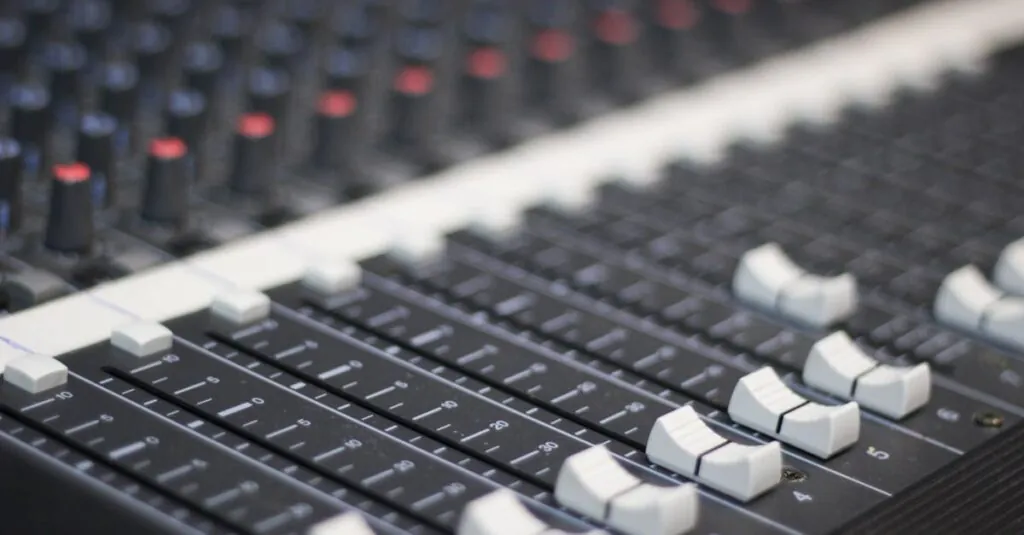In a world where everyone’s chasing the latest tech, audio quality often gets lost in the shuffle. People invest in fancy headphones and high-end speakers but forget the most crucial part: how good does it actually sound? Enter the audio quality test—the ultimate showdown for sound enthusiasts. It’s like a blind date for your ears, and trust us, you want to make sure it’s a match made in audio heaven.
Table of Contents
ToggleOverview of Audio Quality Tests
Audio quality tests assess the performance of sound equipment across various parameters. These tests evaluate fidelity, clarity, and overall listening experience. Sound enthusiasts benefit from understanding the criteria used to measure audio quality before purchasing equipment.
Common metrics in audio quality tests include frequency response and dynamic range. Frequency response measures how well a device reproduces sounds across the audio spectrum, typically from 20 Hz to 20 kHz. Dynamic range refers to the difference between the softest and loudest sounds, indicating the equipment’s ability to deliver a rich listening experience.
Listening tests play a crucial role in assessing audio quality. Participants often compare different audio sources, relying on subjective perceptions to determine performance. Such tests reveal subtle differences that technical measurements may not capture.
Tools used for audio quality tests consist of software and hardware. Signal generators and analyzers provide detailed insights into performance. Additionally, calibrated microphones facilitate accurate measurements, ensuring test reliability.
Standards exist for audio quality testing, such as the AES (Audio Engineering Society) standards. These guidelines provide a framework for reliable and consistent evaluations across various equipment. Following these standards helps consumers and professionals alike make informed decisions.
Consumer awareness of audio quality tests has increased due to the rise of personal audio devices. Reviews and online resources offer valuable insights, fostering informed choices in pursuit of superior sound. Emphasizing sound quality over mere gadget appeal has become a priority among discerning listeners.
Importance of Audio Quality Testing
Audio quality testing plays a crucial role in the tech-driven landscape. It ensures consumers receive superior sound from their devices, directly enhancing their listening experiences.
Impact on Consumer Experience
Audio quality significantly influences how consumers enjoy media. High-fidelity sound enhances immersion, making movies and music more impactful. Listeners often favor devices that deliver rich, clear audio without distortion. Additionally, consumers increasingly recognize the value of sound performance over flashy gadget features. They tend to invest in products that meet their audio expectations, leading brands to prioritize sound quality in their design.
Role in Music Production
In music production, audio quality testing remains a vital step. Producers rely on precise tests to assess recordings across different playback systems. Effective evaluations help create balanced mixes, ensuring music translates well across various devices. Collaborating with engineers in testing setups can highlight areas needing improvement, enhancing the final product’s clarity and depth. Quality sound not only elevates the artist’s vision but also shapes the listener’s experience, directly affecting listener satisfaction and engagement.
Methods of Audio Quality Testing
Audio quality testing employs various methods to evaluate sound performance comprehensively. These methods can be broadly classified into subjective listening tests and objective measurement tools.
Subjective Listening Tests
Subjective listening tests rely on human perceptions to evaluate audio quality. Participants assess audio samples, focusing on clarity, fidelity, and emotional impact. Performers often select tracks that represent diverse genres, ensuring a comprehensive evaluation. Listeners rank their experiences, noting any discrepancies, which highlights differences that technical measurements may miss. Evaluators frequently utilize blind tests to eliminate bias, allowing for more accurate feedback. This approach emphasizes personal preferences, providing insights into how different listeners perceive sound.
Objective Measurement Tools
Objective measurement tools utilize technical equipment to quantify audio performance. These tools include software applications, signal generators, and audio analyzers. Instruments such as calibrated microphones help ensure accuracy during measurements. Frequency response and dynamic range tests provide critical insights into a device’s capability to reproduce sound. Standard measurement protocols by organizations like the Audio Engineering Society offer guidelines for consistent evaluations. By analyzing waveform data and spectral content, engineers capture detailed information that supports or refutes subjective findings. Thus, objective tools play a crucial role in validating audio quality claims.
Common Standards in Audio Quality Testing
Understanding common standards in audio quality testing provides crucial insights into sound performance. Many professionals concentrate on parameters that define excellent audio fidelity.
THD+N (Total Harmonic Distortion plus Noise)
THD+N measures the level of distortion introduced to the audio signal, expressed as a percentage. A lower THD+N value indicates cleaner sound reproduction and less distortion. Many audio enthusiasts prefer devices with THD+N values below 0.1% for optimal clarity. This measurement combines both harmonic distortion levels and noise, offering a comprehensive view of audio integrity. When manufacturers aim for high-quality sound, they often prioritize low THD+N in their designs. Ensuring devices maintain high performance across all genres of music remains essential for delivering a satisfying listening experience.
Frequency Response
Frequency response evaluates how accurately audio equipment reproduces sounds across various frequency ranges. Typically measured in hertz (Hz), this metric indicates device performance from low bass notes to high treble sounds. A flat frequency response contributes to a natural sound with no significant boosts or cuts in specific ranges. Many experts recommend devices with a frequency response spanning from 20 Hz to 20 kHz to cover the full human hearing range. Ensuring devices achieve uniform response within this range enhances the overall listening experience. Audio quality enthusiasts often select equipment based on impressive frequency response curves, seeking equipment that meets their detailed listening needs.
Challenges in Audio Quality Testing
Testing audio quality presents several challenges that affect the accuracy and reliability of results. One major difficulty lies in achieving consistent testing environments. Variations in room acoustics can greatly influence audio perceptions, leading to inconsistent outcomes.
Equipment variability also poses a significant hurdle. Different audio devices may perform uniquely, complicating comparisons across models. This variability necessitates standardized testing protocols to ensure fair evaluations between devices.
Listener bias represents another challenge in audio quality testing. Subjective listening tests depend on personal preferences and experiences, which can introduce inconsistencies in results. While blind testing can reduce bias, it does not eliminate it entirely. Thus, relying purely on subjective tests may not provide a complete picture of audio performance.
Technical limitations of measurement tools must also be considered. Instruments, though advanced, may not fully capture nuances present in audio signals. Some specific issues, like transient response or psychoacoustic effects, require advanced analysis techniques that standard tools may not address.
Properly interpreting data adds layers of complexity to audio quality testing. Analyzing metrics like Total Harmonic Distortion plus Noise can become intricate without clear reference points. Misinterpretation can lead to misconceptions about a device’s actual performance, which could misguide consumers.
Finally, keeping pace with technological advancements in audio gear creates its own set of pressures. Continuous innovations mean standards and testing methodologies must evolve. Adhering to new industry standards becomes essential for maintaining relevant audio quality assessments, ensuring consumers receive the best products.
Audio quality testing is an essential practice for anyone serious about their listening experience. By understanding the various parameters that define sound performance, consumers can make informed choices when investing in audio equipment. This commitment to quality not only enhances personal enjoyment but also supports artists in delivering their vision.
As technology evolves, so does the importance of rigorous testing standards. Staying updated on the latest methods and metrics ensures that listeners can distinguish between mere gadgets and truly exceptional sound. Ultimately, prioritizing audio quality leads to richer experiences and greater satisfaction in every note and beat.




